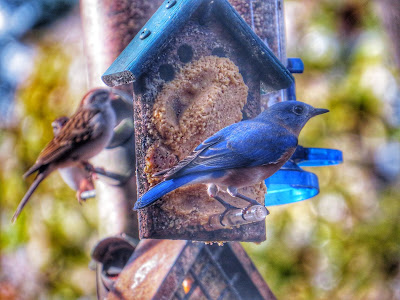New Sightings!
The Hermit Thrush hasn’t been a chance visitor to my backyard feeders. I’ve spotted one a few times since my initial posting a few weeks ago.This book, as in other bird books and online sites, says how the Hermit Thrush has one of the prettiest songs of them all (earning the name “American Nightingale”) and how it is the state bird of Vermont.
Quoting this pithy part from the old book: “It was often remarked that the gaudy bird is rarely a good singer, and the color scheme of the Hermit’s plumage is subdued and inconspicuous to a degree. Furthermore, the bird’s manners are modest and retiring to the point of actual timidity. Always the Hermit seems to be trying to elude notice, and hence his appropriate name.”
Previous Post
There was a surprising visitor to my backyard feeders last week. This one had me fooled for sure.I went on some birding Facebook sites and called this spotted creature a Brown Thrasher.
Well, thrash me 25 times with a stiff feather! Within minutes of my posting, two responses came in saying that my Brown Thrasher is actually a Hermit Thrush.
Just to make sure I went to a third source, whatbird.com’s identification forum, and, yep, people there confirmed this is a Thrush, not a Thrasher.
Here is a photo of a Brown Thrasher that I took in my backyard a while back. You can see the speckled breast similarity. But the Brown is much larger, has a longer beak, and piercing yellow-rimmed eyes.
I automatically assumed the above bird was a Brown Thrasher, a bird I do see regularly on my property. But I stand corrected and I am glad that I was corrected because the Hermit Thrush is a rare visitor indeed.
I can recall only once before seeing and photographing a hermit thrush and that was a number of years ago near Nashville, Tenn. at my sister-in-law's house.
Whatbird.com describes the Hermit Thrush this way: "Small thrush, with olive-brown to red- or gray-brown upperparts, black-spotted white underparts and rufous tail. Distinct white eye-ring. Pink legs, feet. Swift direct flight, may hover briefly over prey. Considered to have one of the most beautiful songs of all North American birds. The state bird of Vermont."
No what about that unusual name? Hermit Thrush? Yes, I'm talking about you!
It proved surprisingly difficult online to find an explanation on the hermit moniker. That's a big miss by the several top North American bird authorities out there, such as Cornell, Audobon and even my trusted whatbird.com site.
So I turned to my robust supply of bird books. In the Smithsonian Handbook's "Birds of North America" is a brief mention about the Hermit Thrush being somewhat solitary but also "often curious and approachable."
Under the "Breeding" section it says "monogamous" and a "solitary nester."
Sounds like this bird may have been stuck with an unusual name that may or may not be that accurately descriptive- and just has to live with it. Considered to have one of the loveliest songs in the bird kingdom, "hermit" just doesn't seem to fit.
On the day I spotted the Hermit Thrush, I also photographed this Yellow-throated Warbler at my feeders. You can see just a sliver of its yellow breast from which comes its name.The beautiful Eastern Bluebird is what first caught my eye. This one was having some bites from the Butter Bark feeder. This is a peanut butter type food only sold at Wild Birds Unlimited. I keep this feeder at the front of my stand because it always gets lots of attention.
That's another Chipping Sparrow in the background.









No comments:
Post a Comment